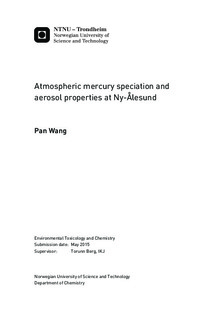Atmospheric mercury speciation and aerosol properties at Ny-Ålesund
Master thesis
Permanent lenke
http://hdl.handle.net/11250/2351958Utgivelsesdato
2015Metadata
Vis full innførselSamlinger
- Institutt for kjemi [1405]
Sammendrag
Gaseous elemental mercury (GEM), reactive gaseous mercury (RGM) and particulate bound mercury (PHg) measurements at Zeppelin station, Ny-Ålesund, Svalbard were analyzed for the correlations with meteorological conditions and aerosol number concentrations.
During the study period from 1 April 2007 to 31 December 2011, a full atmospheric mercury depletion event (AMDE) only appeared at a temperature range of -23 to 12 C. The highest monthly median values of RGM concentrations appeared in April (11 pgm-3) and June (6 pgm-3). PHg concentrations were generally higher in winter-spring period (November-April), and the highest monthly median values appeared in February (17 pgm-3) and April (13 pgm-3).
The meteorological conditions including temperature, relative humidity and precipitation were intimately correlated with the concentrations of GEM, RGM and PHg. AMDEs had a general trend to occur under low temperature, high relative humidity, and low precipitation. It has been found that either very high relative humidity (around 98%) or no accumulated precipitation during the recent few hours backward trajectory would seem to provide a good condition for the high PHg concentrations to occur.
The accumulation mode aerosols with a size range between 100 and 562 nm in diameter seemed to be most characteristic for hosting PHg, and mercury might not tend to associate with particles smaller than 100 nm diameter. PHg might consist of much cloud associated mercury during AMDEs.
